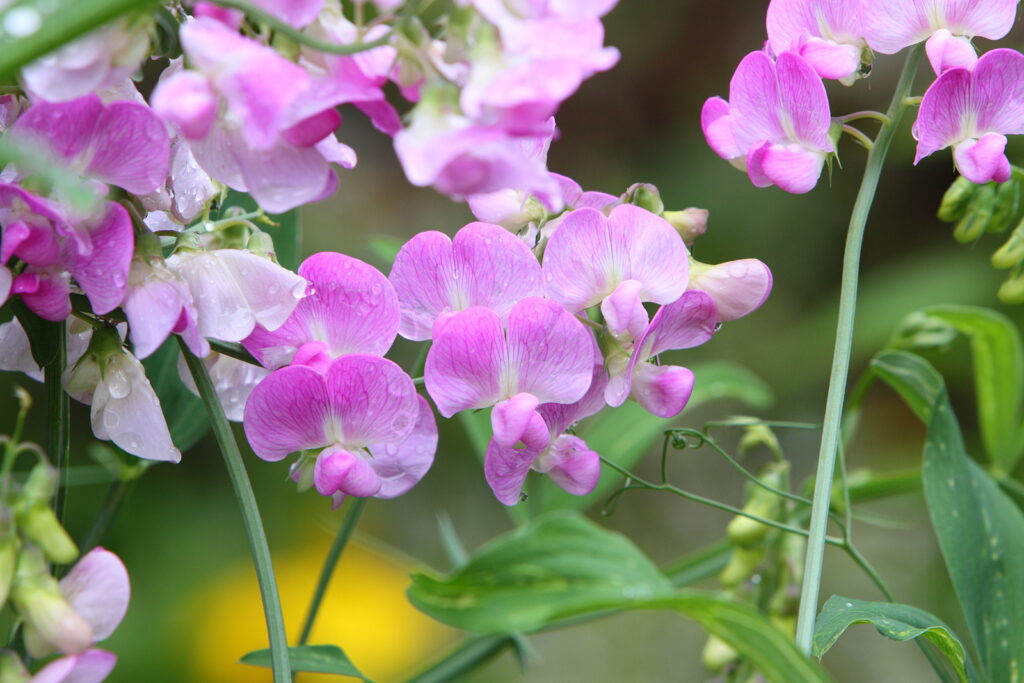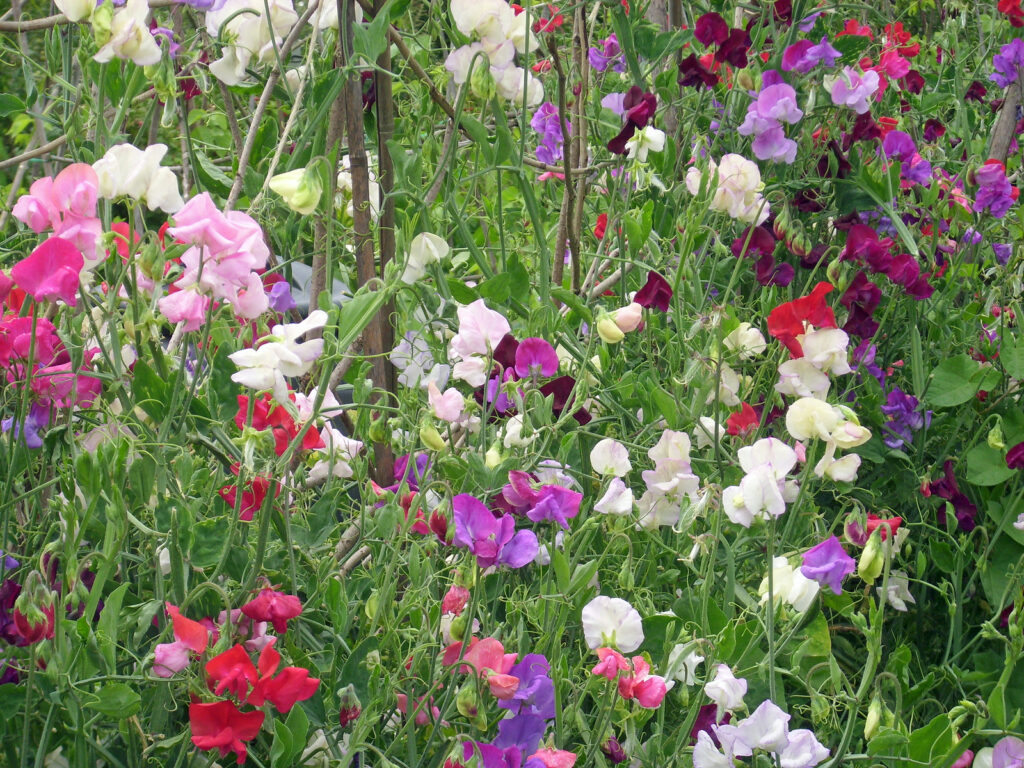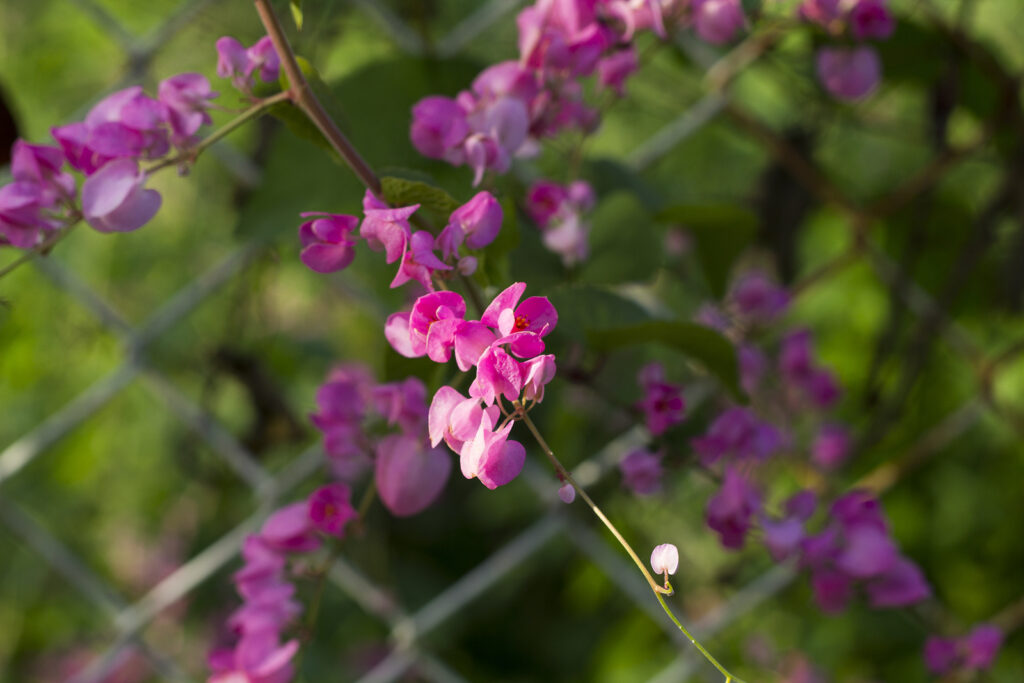Lathyrus–commonly called sweet pea–are a rainbow of colors; some grow as bushes, others as vines climbing arches and trellises. The pea-like sweet pea flowers are dainty, fragrant, and showy. Flowers grow from long, winged stems, often with tendrils.
In mild-winter regions, plant sweet peas in late summer for early winter blooms. In cold-winter regions, plant sweet peas in early spring.
Lathyrus is a leguminous genus of more than 200 species that occur around the world. The vines or erect plants, including, both annuals and perennials, with tendrils and showy flowers ranging from white to shades of red, yellow, and purple, are mostly cultivated for ornament, although a few species bear edible seeds.
Good Products for Seed Starting Success at Amazon:
- Jump Start Germination Station w/Heat Mat Tray, 72-Cell Pack, Dome
- Espoma Seed Starting Mix
- 200 Count- Jiffy 7 Peat Soil Seed Starting Plugs
- Seed Starter Kit with Humidity Dome (120 Cells Total Tray)
- AgrobriteT5 Fluorescent, 2-Foot, Grow Light System
Laythrus perennials are propagated by seeds or cuttings in ordinary soil and will stand in partial shade. the annuals require deep moist soil and full sunlight. Ample support should be provided and the flowers should be kept picked to lengthen the blooming season.

Get to know Sweet Peas
- Plant type: Annual and perennial varieties
- Growing Zones and range: Annual in all zones, perennial in mild-winter regions
- Hardiness: Hardy to -30°F/-34°C; grows best in cool weather of spring; annuals are killed by heavy frost and prolonged heat in the 90sF. Perennials tolerate cold winters and hot summers.
- Height and width: 1 to 8 feet tall (30cm-2.4m), 1 to 2 feet wide; grows as vine or bush
- Foliage: Oval somewhat pointed, soft green leaves grow opposite like wings on long stems; climbers have tendrils
- Flowers: Pealike blooms 1 inch (2.5cm) or wider; a large rounded petal (called the banner or standard), and two lower petals are somewhat united (called the keel); they are held in clusters on long stems; old varieties were known for their sweet fragrance; many newer ones have little or no fragrance.
- Flower colors: Shades of pink, red, purple, lavender, white, cream, apricot, salmon, maroon, and bicolors
- Bloom time: Mid-spring until summer heat comes; any time of the year in mild winter regions
- Uses: Cut flowers; grow on trellises and fences; grow in hanging baskets
- Common name: Sweet pea
- Botanical name: Lathyrus odoratus
- Family: Fabaceae
- Origin: Woodlands in Northern temperate regions and temperate South America
Where to plant Sweet Peas
- Grow sweet peas in full sun.
- Grow sweet peas in humus-rich, well-drained soil.
- Prepare soil outdoors by turning aged compost at least 12 inches (30cm) into the soil.
- Prefers a soil pH of 7 to 7.5
- Sweet peas are best grown in cool, moist climates; in warm climates, grow early-blooming cultivars.
Sweet Pea uses
- Bush types make pretty mounds of color; they soften the front of a border.
- Use a trellis or string supports for clamping types.

When to plant Sweet Peas
- Sow seeds outdoors as soon as the soil can be worked in early spring.
- In mild winter regions, sow in autumn for early-spring bloom. Early flowering types can be sown in mild-winter climates in late summer or early fall for winter bloom.
- Set sweet peas in the garden in spring about the time of the last frost. In Zones 8-11 plant in late autumn or early winter.
- Start seed indoors in early to mid-spring; where there is little frost, start seed in fall and treat plants like biennials.
- Set transplants outdoors after all danger of frost has passed; harden off seedlings in the shade for several days before transplanting.
Planting and spacing Sweet Peas
- Sow seed 1/2 inch deep; the ideal temperature for germination is 60° to 65°F (15.6°-18°C).
- Sow seed 3 inches (7.6cm) apart; thin plants from 1 to 2 feet (30-61cm) apart.
- Soak unwrinkled, dark seeds in warm water for 24 hours then sow ½ inch deep. Wrinkled and tan seeds do not need pre-soaking because they are more likely to rot.
- Treating seed with legume inoculant can help plants hold on to nitrogen and may boost flower yield.
- Set a trellis or arch in place for climbing varieties at planting time.
How to water and feed Sweet Peas
- Keep the soil evenly moist for sweet peas. Do not let the soil dry out.
- Fertilize sweet peas every 2 to 4 weeks with a balanced, all-purpose fertilizer.

Sweet Pea care
- Put a trellis or support in place for vines to grow tall.
- Keep the soil evenly moist; in hot weather, spray plants to cool them off.
- Mulch around sweet peas to conserve soil moisture.
- Feed plants with an all-purpose fertilizer every six weeks through the growing period. Top-dress perennials with compost or leaf mold each autumn.
- Trim spent blooms to encourage more blooms. Cutting fresh flowers will also encourage new blooms.
- Pinch out growing tips to stimulate side branch growth.
- Heat will kill sweet peas; discard spent plants.
- Mulch perennials in winter with several inches of shredded leaves or other light mulch.
- Rabbits and deer will eat the flowers and foliage; use repellants or sprinkle cayenne pepper on plants to discourage rabbits and deer. Wire supports help repel deer; the wire makes them difficult to chew.
Lathyrus pests and diseases
- Lathyrus are susceptible to attacks by slugs and snails on young growth.
- Pythium root rot, powdery mildew, rust, gray mold, and various leaf spots are common.
Sweet Pea propagation
- Soak seed overnight before planting; sweet peas transplant poorly so start them in peat pots that can be set in the garden.
- Treat seeds with an inoculant or soak seeds overnight before sowing; seeds germinate in 14 to 21 days.
- Divide roots of large clumps of perennial vines every other year in early spring; replant divisions immediately.
Sweet Pea varieties to grow
- Lathyrus grandiflora), everlasting sweet pea, long-lived perennial vine to 6 feet in Zones 6-9; rose-purple or red flowers.
- L. latifolius, a perennial pea vine grows 6 to 9 feet tall with rose-pink flowers. With support, they will grow as scrambling mounds. Start from seed in late winter where winters are mild, and early spring in colder regions.
- L odoratus, an annual sweet pea can climb to 6 feet tall on a trellis or arch; often fragrant pink, lavender, red or white flowers. Water deeply and frequently.
- L. vernus, Spring vetchling, clump-forming 1-1.5 foot (.3-.5m) tall perennial that spreads as far. Bears racemes of 3 to 15 purple-blue .8 inch (2cm) wide flowers in spring. ‘Rose fairy’ has 3-inch (7.6cm) wide magenta blooms. Zones 5 to 9.
Sweet Pea frequently asked questions
Q: What is the best way to start growing sweet peas?
A: Sweet peas want cool temperatures, about 50°F, to germinate. Sow sweet peas in a cold frame about a month before the last frost. Sow seeds in individual pots, plant one seed per pot and place them in a sunny window or under fluorescent lights. Seeds can be sown directly in the garden as soon as the soil is workable in spring.
Q: I find sweet peas difficult to germinate. What can I do?
A: Sweet pea seeds have very hard seed coats. Soak the seed in water for 24 hours before sowing, or nick the seed coats with a small file. Be sure to cover the seed completely when planting; they need darkness to germinate.
Q: What growing conditions do sweet peas like?
A: Sweet peas want full or nearly full sun. The soil should be deep and humus rich. Sweet peas prefer a neutral soil pH. Weed around the plants often, water them regularly and feed them weekly with a liquid fertilizer after the buds begin to show.
Q: What is a good way to plant sweet peas to use as cut flowers?
A: Dig a trench 18 inches wide and equally deep. Mix with the soil equal amounts of aged compost and rotted manure, and add some bonemeal at the rate of one pound for every 10 linear feet. Sow the seed in the trench that has been backfilled to about 12 inches; sow the seed 2 inches deep. As the plant grows, gradually fill in the trench.
Q: When should I place support for sweet peas?
A: When sweet peas are about four inches high, place twiggy branches next to plants or among plants growing in clumps. You can also grow sweet peas up chicken wire or netting.
Q: Should I feed sweet peas?
A: Yes. Apply a granular organic fertilizer along the sides of the row when plants are about 4 inches tall.
Q: Why do sweet peas not flower?
A: The soil may be too rich in nitrogen and deficient in phosphorus. Use a 5-10-10 fertilizer. Also, the buds will not open when the weather gets too hot. Hot weather will limit the sweet pea flowering season.
Q: How can I prevent sweet peas from dying in hot weather?
A: Try shading the plant with a light row cover or cheesecloth as soon as hot, dry weather comes. Water the plant thoroughly and regularly. Grow heat-resistant strains such as Royal Family.
Related Articles:
- 20 Perennials That Bloom for 6 to 8 Weeks
- Shrubs with Showy Flowers Season-by-Season
- Trees in Garden Design
- Growing Annuals for Summer Bloom
- Trees—click here for more articles
- Shrubs—click here for more articles
- Perennials—click here to see more
- Annuals—click here to see more



